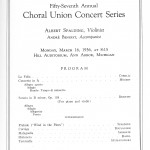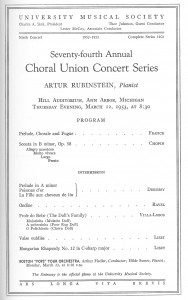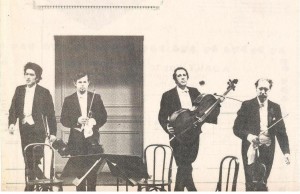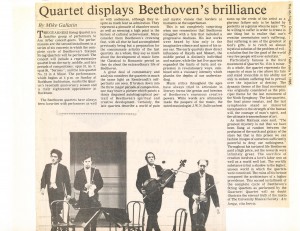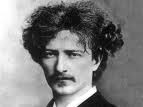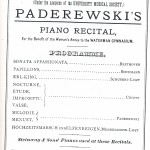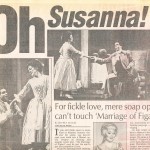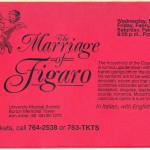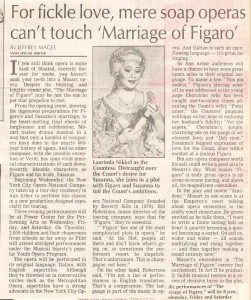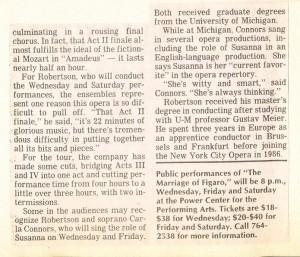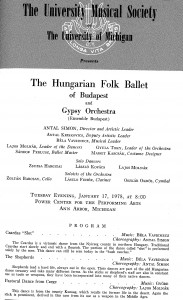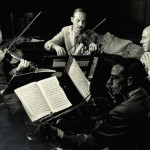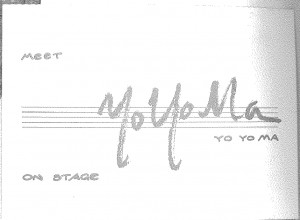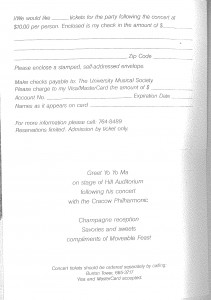This Day in UMS History: Philadelphia Orchestra with Isaac Stern (May 11, 1963)
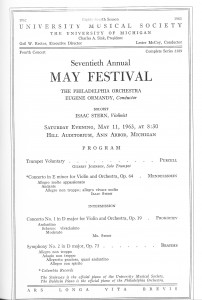 This Day In UMS – May 11, 1963
This Day In UMS – May 11, 1963
Hill Auditorium
The Philadelphia Orchestra
Eugene Ormandy, conductor
Isaac Stern, violinist
Trumpet Voluntary – Purcell
Concerto in e minor for Violin and Orchestra, Op. 64 – Mendelssohn
Concerto No. 1 in D major for Violin and Orchestra, Op. 19 – Prokofiev
Symphony No. 2 in D major, Op. 73 – Brahms
While virtually everyone recognizes the Mendelssohn violin concerto, Prokofiev’s beautiful first concerto is still somewhat of an unknown piece, eclipsed by his more famous second concerto. As it happens, I became familiar with the piece through Stern’s own recording; I have never heard the entire concerto performed live.
It’s interesting to note the difference which chronological perspective makes on one’s criticism of a piece. For me, first approaching it with late 20th century ears, it sounded modern – stark (a bit reminiscent of the opening of the Sibelius violin concerto with the quiet string background, and possibly of Debussy as well in its tone colors) and perhaps a bit harsh. However, I discovered that when it was first composed, it was rejected as being too Romantic; one critic even damned it as being “Mendelssohnian.” I wonder what such critics made of the hopelessly romantic (and lovely) second movement of the second violin concerto. I also wonder whether Stern viewed the concerto as harking back to Mendelssohn, and whether any similarity (or perhaps difference) was behind his programming the two concerti on the same concert.
Stern, of course, had a long history with UMS, with his first performance in Hill Auditorium in 1947, four years after his Carnegie Hall debut at age 23. He subsequently appeared 11 additional times (five recitals and six orchestral performances), with his last performance in 1992. In 2000, he was presented with the UMS Distinguished Artist Award at the Ford Honors Program.
While a video recording of Isaac Stern performing Prokofiev’s Violin Concerto No.1 isn’t currently available, you can hear Vadim Repin here:
“This Day in UMS History” is an occasional series of vignettes drawn from UMS’s historical archive. If you have a personal story or particular memory from attending the performance featured here — or any memories of Isaac Stern’s many appearances in Ann Arbor — we’d love to hear from you in the comments.
This Day in UMS History: Philadelphia Orchestra (May 6, 1962)
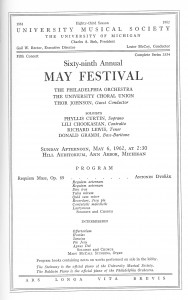 Sunday, May 6, 1962
Sunday, May 6, 1962
Hill Auditorium
The Philadelphia Orchestra
The University Choral Union
Thor Johnson, Guest Conductor
Phyllis Curtin, soprano
Lili Chookasian, contralto
Richard Lewis, tenor
Donald Gramm, bass-baritone
Antonin Dvořák’s Requiem Mass, Op. 89
I’m always curious when I stumble across pieces that I’d never heard of. I know and love Mozart’s, Brahms’s, Verdi’s, and Victoria’s Requiems (and know and intensely dislike Berlioz’), but I never knew that Dvořák had even written one. I immediately searched for it on YouTube, and am listening to it as I write this; the Introitus sounds like the Lord of the Rings soundtrack.
If you’re interested in choral music and/or text in music, a fascinating project is to compare different settings of the Requiem text – it’s startling to see how differently composers deal with the exact same text (the Brahms Requiem, of course, is ineligible for that exact comparison, as the text is different ). Such a comparison is equally possible with the mass text – try Mozart’s Great Mass in c minor, K. 427 with Bach’s Mass in b minor and William Byrd’s Mass for Five Voices.
This concert came in the midst of a series of themed concerts with the Philadelphia Orchestra that May. With various conductors and soloists, the orchestra presented all-Beethoven and all-Strauss concerts, along with evenings of music by British, French, and Russian composers. Back in the 1960s, the annual May Festival ended the regular UMS season, with six different concerts in four days (Thursday, Friday, Saturday afternoon, Saturday evening, Sunday afternoon, and Sunday evening). After presenting the Dvorák Requiem at 2:30 pm on Sunday, May 6, the Philadelphia Orchestra returned for an evening performance that featured Richard Strauss’s Don Juan and Ein Heldenleben, as well as his Burleske in d minor for Piano and Orchestra, performed by the great Hungarian pianist György Sándor, who performed in 16 UMS concerts from 1958-1981.
“This Day in UMS History” is an occasional series of vignettes drawn from UMS’s historical archive. If you have a personal story or particular memory from attending the performance featured here, we’d love to hear from you in the comments.
This Day in UMS History: Mahler’s Symphony No. 8 (March 23, 1997)
Hill Auditorium
March 23, 1997
Mahler’s Symphony No. 8
Grand Rapids Symphony
Catherine Comet, conductor
UMS Choral Union
Grand Rapids Symphony Chorus
Grand Rapids Choir of Men and Boys
Boychoir of Ann Arbor
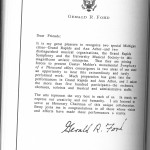 Leafing through the 1997 program book for a March event, this concert struck me because of two things: a letter written by Gerald R. Ford and a picture of Gustav Mahler. Ford, who was the Honorary Chairman of this collaboration between UMS and the Grand Rapids Symphony, recognized with pleasure the cities of Grand Rapids and Ann Arbor, and the organizations that made this evening possible: the Grand Rapids Symphony and UMS.
Leafing through the 1997 program book for a March event, this concert struck me because of two things: a letter written by Gerald R. Ford and a picture of Gustav Mahler. Ford, who was the Honorary Chairman of this collaboration between UMS and the Grand Rapids Symphony, recognized with pleasure the cities of Grand Rapids and Ann Arbor, and the organizations that made this evening possible: the Grand Rapids Symphony and UMS.
Even as a professional musician, there’s a shocking amount of music and music history that I simply don’t know. I have performed five Mahler symphonies (1, 2, 3, 5, and 7), but have never heard Mahler 8, arguably his most famous. Shocking, perhaps, but also wonderful to know that music is a well that will never run dry. After spending four hours rehearsing Bartók’s Fourth Quartet yesterday, I listened to his Second Quartet for the first time ever today. So reading these program notes was an educational experience for me.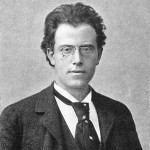
Mahler 8 combines two very different texts: the medieval Catholic hymn “Veni creator spiritus” (“Come, Holy Spirit”) and a scene from Goethe’s Faust (in German, of course). The program note says:
“[Mahler] saw no distinction between humanism and religion; in the Symphony No. 8 he sought to emphasize the link between the early Christian belief in the Holy Spirit which descended on the disciples like tongues of fire. Goethe’s Faust, on the other hand, tells of man’s ascent into a god-like state, transformed from mortality and led heavenward by the ‘Eternal-Feminine.’ Goethe altered the original version of the legend so that Faust is not damned for his sins, but is redeemed through the power of Gretchen’s love. Mahler explained, ‘the essence of it really is Goethe’s idea that all love is generative, creative, and that there is a physical and spiritual generation which is the emanation of this “Eros.”’ The kinship between Platonic love and the early Christian concept of God’s love – both of them able to create, edify, and redeem – unifies these two diverse texts into a single philosophical expression.”
The great conductor Leopold Stokowski, who conducted the US premiere (1916), compared the experience of hearing it for the first time with the impression Niagara Falls must have had on the first early explorers. Mahler said: “Try to describe the whole universe beginning to ring and resound. These are no longer human voices, but planets and suns revolving.”
The heartfelt nature of this piece is indicated in a final quote from the program note:
“Mahler’s wife, Alma, once remarked, ‘Gustav is always on the telephone to God,’ to which his biographer, Michael Kennedy, added, ‘In No. 8 he was on the hot line.”
This Day in UMS History: Albert Spalding (March 16, 1936)
Hill Auditorium
Monday, March 16, 1936
Albert Spalding, violinist
André Benoist, accompanist
This concert caught my eye as having an eerie similarity to the senior recital I just gave a couple weeks ago, on which I played both the Brahms d minor sonata and Corelli’s La Folia, in addition to another Mozart piece in A major (although a sonata, not the concerto…the differences in concert programming between today and the early 20th century could make up an entire blog entry). Albert Spalding was one of those violinists whom I had sort of heard of, but never really knew much about him, so it was interesting to research him.
First, to dispel confusion: he is not the Albert Spalding who was a Hall of Fame baseball pitcher and who founded the sports equipment company. That Spalding (the pitcher) was Spalding’s (the violinist) uncle.
Spalding was American, born in Chicago in 1888, although during his adolescence, his family wintered in Florence. Until the First World War, he followed the typical path of a violinist: studies at the Bologna and Paris Conservatories; the de rigueur meeting with Joseph Joachim; solo performances throughout Europe and the United States. The outbreak of the war caused him to cancel plans for a tour to South America. Instead, he enlisted in the army, serving in Italy and the doing secret service work in Spain. After the war, he returned to the states and married.
However, it’s an episode during the Second World War that really highlights both Spalding and the power of music. During an aerial bombardment of Naples, in which thousands of terrified refugees were huddled in a cave, Spalding “borrowed a violin from a symphony musician he observed in the crowd. As the first the tones of Beethoven Concerto floated unaccompanied through the shelter the cries and moans ceased instantly. By the time the concerto was ended, peace, calm and quiet had been brought, if only for a brief space, to the wretched and unhappy people. Persons present on that occasion have written and stated that they had never heard such a great performance nor had they ever seen the power of music so convincingly illustrated.” (From the liner notes of Albert Spalding Plays Beethoven “Kreutzer” Sonata and Bach Chaconne)
If you’d like to see the original concert program pages, click the thumbnail, which will direct you to the recently launched UMS digital archive hosted by the Ann Arbor District Library. Here you’ll find over 100 years of programs and photos from UMS.
Program:
Corelli: La Folia [Sonata in d minor, Op. 5 #12]
Mozart, Concert in A [#5, K. 219, “Turkish”]
Brahms: Sonata in d minor, Op. 108
Spalding: Prelude (“Wind in the Pines”)
Boulanger: Cortège
Sarasate: Malagueña
Ravel: Habanera
Szymanowski: Tarentelle
This Day in UMS History: Artur Rubinstein (March 12, 1953)
March 12, 1953
Hill Auditorium
Artur Rubinstein, pianist
There are a few musicians with whom I’d love to sit down and have a conversation. Bach, certainly, to ask him how he wrote such incredible counterpoint. Mozart, just to joke around with (although I also have a bone to pick with one of his doublings in the last movement of the D major K. 499 string quartet). Some I’d just be content to hear play: Paganini, for instance, or Joseph Joachim. Rubinstein fits into both categories: by all accounts his playing was arresting (certainly the recordings I’ve heard are), and, judging by his memoirs My Young Years, quite an entertaining companion as well.
The Arthur Rubinstein International Music Society has this to say about Rubinstein:
“Arthur Rubinstein represented in both his life and his music-making a unique joie de vivre. That alone would set him apart in this serious musical age, where there is a high degree of skill but very little charm or poetry. Arthur Rubinstein was able to communicate joy in his playing. He loved the piano, he loved the music he played, and he was always able to charm audiences all over the world with one of the most extraordinary personalities that this century has seen.
In his long life he saw interpretation pass from Romanticism to the percussionism of Bartók and Prokofiev, and then to the literalism brought in by the anti-Romantic movement, in which young pianists were trained to observe only the printed note, keeping themselves out of music. Rubinstein did not like what he heard. He realized, as all great artists do, that music means nothing until brought to life by an imaginative, sympathetic player. He knew that it was the function of the interpreter to refract the message of the composer through the prism of his own mind. Otherwise a robot could do the job as well.
Perhaps the example of his own life, and of the many great recordings he left, will spur young artists…to be their own masters, to realize that there is more to music than merely playing the notes correctly, to make music with a big mind and a big conception that not only reproduces the notes but also transcends them.”
I highly recommend reading their entire bio of Rubinstein.
Here’s the program from 1953:
Franck: Prelude, Chorale and Fugue
Chopin: Sonata in b minor, Op. 58
Debussy: Prelude in a minor; Poissons d’or; La Fille aux cheveux de lin
Ravel: Ondine
Villa-Lobos: Prole do Bebe (The Doll’s Family)
Liszt: Valse oubliée
Liszt: Hungarian Rhapsody No. 12 in C-sharp minor
“This day in UMS History” is an occasional series of vignettes drawn from UMS’s historical archive. If you have a personal story or particular memory from attending the performance featured here, we’d love to hear from you in the comments.
This Day in UMS History: Royal Philharmonic Orchestra (Feb 19, 1985)
Editor’s Note: Royal Philharmonic Orchestra performs in Ann Arbor on January 11, 2016.
February 19, 1985
Hill Auditorium, Ann Arbor
Royal Philharmonic Orchestra
Yehudi Menuhin, conductor
“While Yehudi Menuhin’s name is synonymous with the violin, he is also regarded as one of today’s finer conductors.” So begins the biographical note for the concert of this orchestra, which in 1986 counted André Previn as its Music Director and the Queen Mum as its patron. Menuhin’s name is indeed synonymous with the violin, but even for a violinist he had an unusual life. He was raised in California, studied in Europe with Georges Enesco, and as a teenager was an internationally famous violinist. During World War II, he flew, sometimes in dangerous conditions, to military hospitals to perform for wounded soldiers – acts for which France later honored him with the Legion of Honor (making him its youngest recipient). He was a close friend and collaborator with famous Indian sitarist Ravi Shankar (who, still going strong at 90 years old, recently appeared at Hill with his daughter Anoushka) and released joint recordings with legendary jazz violinist Stephane Grappelli. He founded the Yehudi Menuhin School in Surrey, England, received fourteen honorary doctorates, and was made a life peer by Queen Elizabeth II. He died in 1999.
“This day in UMS History” is an occasional series of vignettes drawn from UMS’s historical archive. If you have a personal story or particular memory from attending the performance featured here, we’d love to hear from you in the comments.
This Day in UMS History: Guarneri String Quartet (Feb 18, 1986)
February 18, 1986
Rackham Auditorium, Ann Arbor
Guarneri String Quartet
Arnold Steinhardt & John Dalley, violins
Michael Tree, viola David Soyer, cello
One of the first questions I was asked at UMS was “What event are you most excited for this season?” “The Guarneri Quartet!” was my enthusiastic response. I grew up on their recording (the earlier version) of the Beethoven string quartets. I heard my violin teacher tell stories about Michael Tree playing passages in the Mendelssohn Octet over the bridge to make sure he could be heard. I had read and loved Arnold Steinhardt’s two books, Indivisible by Four and Violin Dreams. And so I was pretty excited that UMS had snagged them on their farewell tour, and that I would get to hear them play two late Beethoven quartets.
This 1986 performance was already the Guarneri’s 20th performance with UMS. They were in the midst of a Beethoven cycle, performing the Quartets in Eb major, Op. 74 (“The Harp”), A major, Op. 18 #5, and e minor, Op. 59 #2. This formation, of course, had their original cellist, David Soyer. (The group was founded in 1964 and retained all its original members until Mr. Soyer retired in 2001 and was replaced by his student and former Beaux Arts Trio cellist Peter Wiley.) The Guarneri Quartet returned in the 1986-1987 season to finish off their Beethoven cycle.
“This day in UMS History” is an occasional series of vignettes drawn from UMS’s historical archive. If you have a personal story or particular memory from attending the performance featured here, we’d love to hear from you in the comments.
This Day in UMS History: “Paderewski’s Piano Recital” (Feb 15, 1892)
February 15, 1892
University Hall, Ann Arbor
During my time at UMS, I’ve become used to seeing the ghosts of famous musicians. I’ve stumbled across signed photos of Jascha Heifetz (for whose violin classes current U-M Professor Martin Katz played) and records of Sergei Rachmaninov’s appearances at Hill. Even so, I did a double take when I found the program for Ignace Paderewski. The billing simply said “Paderewski’s Piano Recital”, adding that it was “For the Benefit of the Woman’s Annex to the WATERMAN GYMNASIUM.” I figured it was a society named after the Polish composer-pianist, and was very excited to discover that it was in fact a recital by Paderewski himself. I was even more excited to learn more about this pianist – I knew from Arthur Rubinstein’s memoirs that he was an inspirational pianist, mentor, and composer – but I also found out that he was an ardent Polish patriot, and was even Prime Minister of Poland for a brief time.
His recital program was formidable (Beethoven, Schumann, Chopin, Liszt transcriptions of works by Schubert and Mendelssohn, and his own compositions), as befits a pianist who had just conquered the musical capitals of Europe (UMS’ archives includes a biography of Paderewski by a London reviewer) and was in the process of doing the same to America’s musical capitals – then as now including Ann Arbor. Paderewski returned to Ann Arbor five more times, the last in 1933. He died while on tour in New York City in 1941. He was buried in Arlington National Cemetery until 1992, when his remains were brought to Warsaw.
“This day in UMS History” is an occasional series of vignettes drawn from UMS’s historical archive. If you have a personal story or particular memory from attending the performance featured here, we’d love to hear from you in the comments.
This Day in UMS History: New York City Opera , The Marriage of Figaro (Feb 13-15, 1991)
February 13-15, 1991
Power Center, Ann Arbor
New York City Opera
The Marriage of Figaro
Music by Wolfgang Amadeus Mozart
Libretto by Lorenzo da Ponte
While Mozart’s Marriage of Figaro may be timeless, opera production sure isn’t. The program notes for this production of Figaro note that the company “features its popular and much-praised supertitles, an innovation in opera that clarifies all of the action onstage while preserving the integrity of the original language libretto.” Opera plots are complicated enough as it is without having to worry about reading the translations by the dim light in the theatre! And yet only twenty years ago, that’s exactly what audiences had to do.
The New York City Opera was founded in 1943 and, in addition to opera gems such as Figaro, has a repertoire of 273 works spanning five centuries of music and including 29 world premieres and 61 American and/or New York premieres of such notable works as Bartók’s Bluebeard’s Castle, Britten’s A Midsummer Night’s Dream, Shostakovich’s Katerina Ismailova, Prokofiev’s The Love for Three Oranges and The Flaming Angel, Schoenberg’s Moses und Aron, and Glass’ Akhnaten. The company has been a leading showcase for young artists, helping to launch the careers of more than 3,000 singers, including UM alumnus David Daniels, Plácido Domingo, Renée Fleming, and Beverly Sills.
“This day in UMS History” is an occasional series of vignettes drawn from UMS’s historical archive. If you have a personal story or particular memory from attending the performance featured here, we’d love to hear from you in the comments.
This Day in UMS History: Kiri Te Kanawa and Martin Katz (Feb 10, 1987)

Martin Katz
February 10, 1987
Kiri Te Kanawa, soprano
Martin Katz, pianist
Hill Auditorium, Ann Arbor
Soprano legend Kiri Te Kanawa and U-M Professor of Piano Martin Katz gave a recital of Handel, Mozart, R. Strauss, and arrangements of folk songs by Canteloube and Gamley. It was a linguistically eclectic program, with the Italian of Handel’s Giulio Cesare excerpts, the Latin of Mozart’s Exultate Jubilate, German in Richard Strauss’ songs, English folksongs arranged by Gamley, and, most interestingly, the Occitan of Canteloube’s Five Songs of the Auvergne. Occitan, also known informally as Languedoc or Provençal, is a Romance language. In medieval times, it was the language of the troubadours; it is now spoken in southern France and a few areas of Italy and Spain. These charming songs were collected and arranged by Canteloube as a way to preserve the linguistic legacy of Occitan.
Below Dame Kiri Te Kanawa sings 4 songs from “Chants d’Auvergne” by Joseph Canteloube (1879-1957).
1. Lou Coucut
2. Lo Fiolaire
3. Lou Boussu
4. Malurous quo uno fenno
Piano / Roger Vignoles. Recorded from the recital “Chanson de la France” , 1986.
“This day in UMS History” is an occasional series of vignettes drawn from UMS’s historical archive. If you have a personal story or particular memory from attending the performance featured here, we’d love to hear from you in the comments.
Chicago Symphony Orchestra & UMS: The Ultimate Long-Term Relationship
Editor’s note: Chicago Symphony Orchestra returns to Ann Arbor on October 29, 2015.
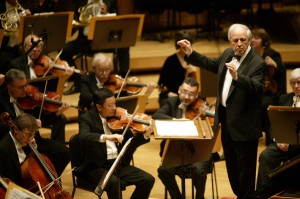
Pierre Boulez conducting the CSO (photo: Todd Rosenberg)
The Chicago Symphony Orchestra’s January 27, 2010 appearance in Hill Auditorium is the 202nd in a series of performances under UMS auspices that began over a century ago, on November 21, 1892. The orchestra, then known as the “Chicago Orchestra” was conducted by Theodore Thomas in typically eclectic (for its time) program of Weber (Overture to “Freyschuetz”), Beethoven (Allegretto from the Seventh Symphony), Tchaikovsky (Suite from Ballet, Casse Noisette – billed as a “new” work, as indeed it was for its time), and Wagner (Vorspiel from Meistersinger).
The CSO’s complete UMS performances are too numerous to mention even in the scantiest detail, but there are several concerts which caught my eye as I was browsing UMS’ archives.
In UMS’ May Festival of 1931, the CSO was the resident orchestra in several concerts. One of those concerts featured an oratorio by French composer Gabriel Pierné on the life of St. Francis of Assisi – with such vocal roles as “The Leper” and “The Voice of Christ” (both sung by the same person), “The Lady Poverty”, and “Birds” (sung by a children’s chorus). Another concert featured legendary Polish pianist Ignace Paderewski, performing his own piano concerto and solo piano works by Chopin.

Arthur Grumiaux
There is an interesting anachronism in the program for the CSO’s March 1952 performance with the great violinist Arthur Grumiaux. Grumiaux is listed as playing Bartók’s “Concerto for Violin and Orchestra,” as though he had only written one violin concerto. Bartók in fact wrote two violin concerti, but the first, although written in 1907-08 (for a woman he was in love with, but who rejected him), was not published until 1958, after Bartók’s death (and after this performance of the second concerto with Grumiaux and the CSO).
The CSO has a long history with the works of Richard Strauss, having given the U.S. premieres of most of the great tone poems, including Till Eulenspiegel and Ein Heldenleben. Strauss was also the CSO’s first guest conductor, in 1904; after the first rehearsal with the CSO, he said to the orchestra, “I am delighted to know you as an orchestra of artists in whom beauty of tone, technical perfection, and discipline are found in the highest degree.” The CSO brought that tradition to Ann Arbor in March 1992 with a performance of Strauss’s Don Juan, Till Eulenspiegel, and Ein Heldenleben, conducted by Daniel Barenboim.
The CSO’s most recent UMS performance was in December 2005 with guest conductor Robert Spano and the Marcus Roberts Trio, performing Ralph Vaughn Williams’ Symphony #2, George Gershwin’s Rhapsody in Blue, and Leonard Bernstein’s Symphonic Dances from West Side Story.
This Day in UMS History: Mummenschanz (Jan 26 & 27, 1987)
January 26 & 27, 1987
Power Center
Mummenschanz
A Journey Into The Imagination
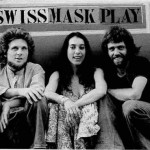 In 1972, Swiss actors Bernie Schürch and Andres Bossar and Italian-American actress Floriana Frassetto formed their now celebrated visual theatre group. They gave themselves an original name, Mummenschanz (roughly meaning masquerade), and set out with a sense of fun and imagination to invent a new form of theatre. Though each had a different background, the three artists were united by a common goal: to create a non-verbal theatrical language that would transcend the traditional barriers of nationality and culture. Since their first performance, these artists have thrilled audiences around the world with a spectacular and revolutionary nonverbal theatrical style, and have created figures and fantasy creatures in the shape of versatile face masks, half-body to whole-body masks and three-dimensional sculptural heads. I’m posting two vintage Mummenschanz videos. Above you’ll see a stage performance by Mummenschanz from 1983, and below a 1976 appearance on the Muppet Show.
In 1972, Swiss actors Bernie Schürch and Andres Bossar and Italian-American actress Floriana Frassetto formed their now celebrated visual theatre group. They gave themselves an original name, Mummenschanz (roughly meaning masquerade), and set out with a sense of fun and imagination to invent a new form of theatre. Though each had a different background, the three artists were united by a common goal: to create a non-verbal theatrical language that would transcend the traditional barriers of nationality and culture. Since their first performance, these artists have thrilled audiences around the world with a spectacular and revolutionary nonverbal theatrical style, and have created figures and fantasy creatures in the shape of versatile face masks, half-body to whole-body masks and three-dimensional sculptural heads. I’m posting two vintage Mummenschanz videos. Above you’ll see a stage performance by Mummenschanz from 1983, and below a 1976 appearance on the Muppet Show.
“This day in UMS History” is an occasional series of vignettes drawn from UMS’s historical archive. If you have a personal story or particular memory from attending the performance featured here, we’d love to hear from you in the comments.
This Day in UMS History: Debut of the Camerata Orchestra of Salzburg (Jan 20, 1978)
January 20, 1978
Rackham Auditorium
Camerata Orchestra of Salzburg
One of my personal favorite UMS concerts was the October 2008 presentation of violinist Anne-Sophie Mutter and the Camerata Orchestra of Salzburg with the complete Bach violin sonatas. Any orchestra that specializes in Baroque and Mozart, especially one from Mozart’s native town, has a pretty good spot in my musical pantheon. The Orchestra made its UMS debut in January 1978 with a performance of Handel, Boccherini, Mozart, and Vivaldi’s Concerto for Four Violins (as a violinist, I don’t think this piece is performed nearly often enough). The Orchestra was founded in 1952 with the original intention of specializing in Renaissance and Baroque music; it soon became evident that the orchestra had a special love for Mozart, and expanded its repertoire to include many of his works. The video above features a recent performance by Anne-Sophie Mutter with the Camerata Salzburg.
“This day in UMS History” is an occasional series of vignettes drawn from UMS’s historical archive. If you have a personal story or particular memory from attending the performance featured here, we’d love to hear from you in the comments.
This Day in UMS History: Hungarian Folk Ballet of Budapest (Jan 17, 1978)
January 17, 1978
Power Center
Hungarian Folk Ballet of Budapest and Gypsy Orchestra (Ensemble Budapest)
We hear a lot about Hungarian composers – Bartók and Liszt are common fare for music lovers, and even Haydn himself spent much of his life in the Hungarian country estate of Esterházy. But much less common is the chance not only to hear Hungarians perform their own music, but also to see Hungarian dancers perform traditional dances. The audience at the Power Center 21 years ago got to see a real Czardas, which the program says is “a virtuosic dance from northern Hungary.” Traditional Czardas start slowly and end with a flourish…This dance can still be seen today in the ‘bush ranches.’” I wish I’d been there to hear the Gypsy Orchestra play Franz Liszt’s Hungarian Fantasy, of which the program says, “Liszt adapted the most popular tunes of his age into this rhapsody, particularly the ‘verbunk’ or recruiting dance…The rhapsodic form of this fantasy gives us a thrilling and throbbing picture of Hungarian folk music as treated by one of the world’s greatest composers.” The video above is an example of the verbunk as danced by the Romafest Gypsy Dance Theater.
“This day in UMS History” is an occasional series of vignettes drawn from UMS’s historical archive. If you have a personal story or particular memory from attending the performance featured here, we’d love to hear from you in the comments.
This Day in UMS History: The Paganini Quartet (Jan 16 & 17, 1948)
January 16 & 17, 1948
Rackham Auditorium
The Paganini Quartet
Henri Temianka, first violin
Robert Courte, viola
Gustave Rosseels, second violin
Gábor Rejtö, violoncello
In 1948, Bartók was new music – the composer had died only two years before. The first of the Paganini Quartet’s three concerts at Rackham Auditorium in the space of two days started in the Baroque with an arrangement of a Vivaldi concerto, traveled through the late and great Beethoven Quartet in B-flat major, Opus 130 (for the quartet fanatics out there, they performed the new ending Beethoven wrote for the piece, not its original ending, now known as the Grosse Fuge, Op. 133) and ended with the first of Bartók’s six string quartets. The Paganini Quartet has its own connection to Ann Arbor and the UM community: Gustave Rosseels, the second violinist, became a Professor of Violin in 1957 at the UM School of Music (as it was known then). His name survives in the scholarship for a string quartet, to be given annually to a UM student string quartet and to be called the Rosseels Quartet – of which, incidentally, I am currently the first violinist.
The three concerts by the Paganini Quartet comprised UMS’s 8th Annual Chamber Music Festival (the precursor a today’s Chamber Arts Series). Below is the original advertisement from 1948 — the best seats for season tickets cost only $3.60!
“This day in UMS History” is an occasional series of vignettes drawn from UMS’s historical archive. If you have a personal story or particular memory from attending the performance featured here, we’d love to hear from you in the comments.
This Day in UMS History: The Cracow Philharmonic (Jan 11, 1986)
January 11, 1986
Hill Auditorium
The Cracow Philharmonic (Orchestra of the Karol Szymanowski Philharmonic in Cracow)
Tadeusz Strugala, principal conductor and artistic director
Krzysztof Penderecki, guest conductor
Yo-Yo Ma, cellist
Program
Penderecki: The Awakening of Jacob (1974)
Penderecki: Concerto #2 for Cello and Orchestra (1982)
Shostakovich: Symphony #6 in b minor, Op. 54 (1939)
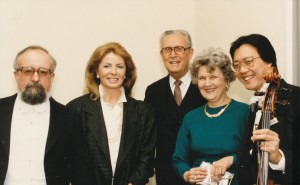
Backstage at Hill Auditorium: (from left to right) Composer & Conductor Krzysztof Penderecki with wife Elzbieta, UMS President Gail Rector and wife Beth, Cellist Yo-Yo Ma (from the UMS Photo Archive)
Hill Auditorium saw a remarkable meeting of cultures at this concert: a Polish orchestra gave the Ann Arbor premiere of a Russian symphony, and a Chinese-American cellist played a cello concerto written by a Polish composer for a Russian cellist, Mstislav Rostropovich.
Born in 1933, Krzysztof Penderecki was at the forefront of classical composition, and had been called “the musical personification of Poland.” He had already written a violin concerto for Isaac Stern, a Christmas Symphony for Zubin Mehta and the New York Philharmonic, and a Te Deum, dedicated to his fellow-countryman Pope John Paul II. His Polish Requiem, inspired by Poland’s Solidarity Movement, was premiered under the baton of Rostropovich in 1984.
UMS audiences have seen Yo-Yo Ma many times over the years, most recently in 08/09 UMS season with the Silk Road Ensemble. Twenty-three years ago, at age 30, he was already a veteran of the classical music world, having won a Grammy for his recording of the Bach Suites for Solo Cello (1984) and being described by the London Daily Telegraph as “among the finest instrumentalists of our time.”
At this concert, UMS audience members were invited to meet Yo-Yo Ma on the Hill Auditorium stage after the concert. Here’s a scan of the original invitation.
“This day in UMS History” is an occasional series of vignettes drawn from UMS’s historical archive. If you have a personal story or particular memory from attending the performance featured here, we’d love to hear from you in the comments.



